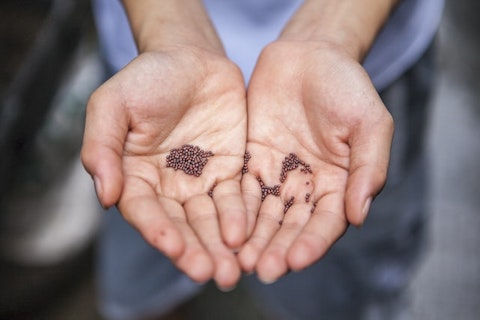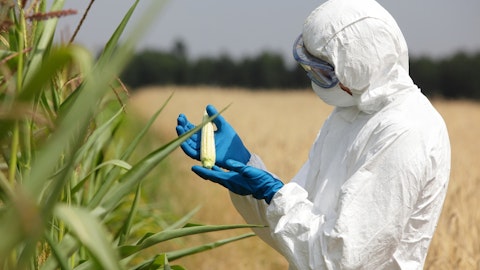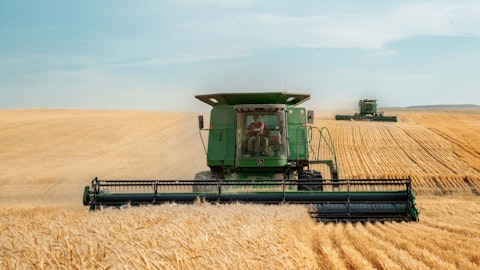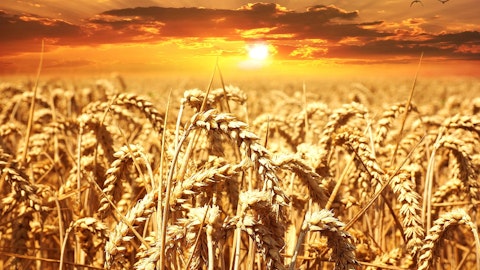Corteva, Inc. (NYSE:CTVA) Q4 2022 Earnings Call Transcript February 2, 2023
Operator: Good day and welcome to the Corteva 4Q 2022 Earnings Call. Today’s call is being recorded. At this time, I’d like to turn the conference over to Kim Booth, Vice President of Investor Relations. Please, go ahead.
Kim Booth: Good morning and welcome to Corteva’s fourth quarter and full year 2022 earnings conference call. Our prepared remarks today will be led by Chuck Magro, Chief Executive Officer; and Dave Anderson, Executive Vice President and Chief Financial Officer. Additionally, Tim Glenn, Executive Vice President, Seed Business Unit; and Robert King, Executive Vice President, Crop Protection Business Unit, will join the Q&A session. We have prepared presentation slides to supplement our remarks during this call, which are posted on the Investor Relations section of the Corteva website and through the link to our webcast. During this call, we will make forward-looking statements which are our expectations about the future. These statements are based on current expectations and assumptions that are subject to various risks and uncertainties.
Our actual results could materially differ from these statements due to these risks and uncertainties, including, but not limited to, those discussed on this call and in the Risk Factors section of our reports filed with the SEC. We do not undertake any duty to update any forward-looking statements. Please note, in today’s presentation, we’ll be making references to certain non-GAAP financial measures. Reconciliations of the non-GAAP measures can be found in our earnings press release and related schedules, along with our supplemental financial summary slide deck available on our Investor Relations website. It’s now my pleasure to turn the call over to Chuck.
Chuck Magro: Thanks, Kim. Good morning and thanks for joining us today. I hope everyone’s year is off to a great start. There are several key messages I’d like to share with you today including our strong 2022 performance, an overview of the market fundamentals and an update on our value creation plan, with a closer look at what’s ahead for 2023. Corteva executed well amidst a dynamic market environment, delivering double-digit sales and operating EBITDA growth, as well as over 200 basis points in margin expansion. Enlist E3 soybeans reached about 45% market penetration in the US and new product sales in Crop Protection reached over $1.9 billion for the full year, an increase of more than 30% over prior year. On capital deployment, we returned more than $1.4 billion to shareholders via dividends and share repurchases for the full year.
Our 2022 results support the value creation plan presented at Investor Day, where we outlined a framework to achieve $4.4 billion of EBITDA by 2025, with a margin range of 21% to 23% and we’re on track to do just that. The framework is simple and straightforward and hinges upon four key elements: portfolio simplification, royalty neutrality, product mix and operational improvements. The strategic and operational actions implemented since we announced the plan, show that we are already making progress on accelerating our performance and we were even able to achieve some of that value in 2022. We remain committed to our value creation plan and 2023 is going to be a year largely focused on execution. As a reminder, a critical part of our refined strategy involves increasing investment in R&D.
We’re focused on delivering greater value to farmers through more differentiated and sustainably advantaged solutions and leveraging our pipeline to drive advancements in global food security and climate change. On the M&A front, we announced our intent to acquire Symborg and Stoller, two biological acquisitions which are both set to close in the first half of 2023. These acquisitions reinforce our commitment to providing farmers with environmentally friendly sustainable tools with proven effectiveness that complement evolving farming practices and help them meet changing market expectations. As communicated previously, we expect that biologicals will be the fastest-growing segment in the Crop Protection industry over the next decade. Turning to the outlook.
We entered 2023 well positioned with best-in-class technologies to continue to deliver market-leading value for our customers, as we tilt our portfolio towards our differentiated offerings. This is a big step change year for our Enlist platform. We’re expecting E3 US soybean market penetration in the mid-50s and a royalty reduction benefit of over $100 million. Organic sales of new Crop Protection products including our Enlist herbicide are expected to grow by an additional 20%. And we’re on track to cross $1 billion in annual sales with our Spinosyns franchise. More broadly, we expect that favorable pricing and mix in addition to productivity and restructuring benefits will continue to outpace headwinds associated with cost inflation. We will also continue to monitor the effects of currency, which we believe will be a headwind this year.
As a result for 2023, we expect to deliver 5% sales growth in between $3.4 billion and $3.6 billion in operating EBITDA translating into yet another year of impressive margin expansion. Now let’s spend a few minutes on the market outlook on slide 5. Market fundamentals remain constructive, as we enter 2023. Global grain and oilseed stocks are tight, due to last year’s below trend yields which were impacted by dry weather in the Northern Hemisphere and the war in Ukraine. Crop prices which remained well above historic averages are supported by tight supply-demand fundamentals globally. Farmers are financially healthy with strong liquidity and they will continue to prioritize yield to meet market demand and offset inflationary pressures. Farm income is expected to be one of the largest ever, albeit below the record achieved in 2022.
And demand for corn and soybean oil, is expected to grow in 2023 supported by strong energy prices and policy adjustments focusing on low-carbon energy sources. Crop area is forecasted to be up in most major crop-producing regions in 2023. The USDA gave a January update indicating U.S. planted area is estimated to be 91 million acres for corn and 89 million acres for soybeans, both showing increases versus 2022. We continue to monitor the effects of weather around the globe including the drought conditions in Argentina. Brazil is projecting that national grain output, for the 2022-2023 crop season will be a new record, translating to low- to mid-single-digit growth. We expect these positive market conditions to continue throughout the year and could extend well past 2023 depending on supply-demand dynamics which is consistent with our previous messaging, that global grains and oilseed inventories need to be rebuilt over at least two years.
And with that let me turn it over to Dave to provide details on our financial performance, as well as updates on the 2023 outlook.
Dave Anderson: Thanks Chuck and welcome everyone to the call. Let’s start on slide 6 which provides the financial results for the quarter and full year. You can see in the table, we finished 2022 with another quarter of strong performance. Quickly touching on the fourth quarter, organic sales were up 11% versus prior year, led by Latin America and North America. The strong organic sales translated into earnings of $370 million for the quarter more than 200 basis points of margin improvement. Turning to the full year, organic sales grew 15% versus 2021 with broad-based pricing and volume gains. Global pricing was up 10% over prior year with notable gains in both seed and crop protection. Seed volumes were flat due mostly to lower planted area in the U.S. Canola supply constraints and the impact of our Russia exit in EMEA.
Crop Protection volume was up 9% for the year, driven by strong demand for new products. These new products delivered over $475 million of sales growth year-over-year an increase of more than 30%. We delivered $3.2 billion in operating EBITDA for the year an increase of 25% over the prior year. Pricing product mix and productivity more than offset higher input costs and currency headwinds. This earnings improvement translated into more than 200 basis points of margin expansion year-over-year reflecting the strength in execution by our organization. And as Chuck said, 2022 is an early installment on our multiyear performance goals that we shared with you at Investor Day. So let’s now go to slide 7. You can see the broad-based growth with strong organic sales gains in every region for the full year 2022.
In North America organic sales were up 10%, driven by crop protection on demand for new technology including Enlist herbicide. Seed volumes were down versus prior year, primarily due to a reduction in U.S. corn acres and supply constraints for canola in Canada. Soybean volumes were up 7% driven by penetration of Enlist. Both seed and Crop Protection delivered pricing gains with pricing up 6% and 14%, respectively. In Europe, Middle East and Africa, we delivered 18% organic growth compared to prior year, driven by price and volume gains in both segments. Seed pricing increased 11% and helped to mitigate currency impacts. In Crop Protection demand remains high for new and differentiated products driving volume growth of 15% for the year. In the fourth quarter volumes were muted by approximately $50 million related to the war in Ukraine in our previously announced exit from Russia.
In Latin America, organic sales increased 23% with notable gains in both price and volume. Pricing increased 16% compared to prior year, driven by our price for value strategy coupled with increases to offset rising input costs. Seed volumes increased 4% with some pressure due to tight supply of corn, while Crop Protection volumes increased 10% driven by demand for new products. Asia Pacific organic sales were up 9% over prior year on both volume and price gains. Seed organic sales increased 23% on strong price execution and the recovery of corn-planted area. Crop Protection volume was down 1% due to wet weather and low pest pressure in certain areas, partially offset by demand for new products. So with that let’s go to slide 8 for a summary of 2022 operating EBITDA performance.

Photo by Joshua Lanzarini on Unsplash
For the full year, operating EBITDA increased approximately $650 million to $3.2 billion. And as I covered on the prior slide, strong customer demand drove broad-based organic growth with price and volume gains in all regions and we particularly benefited from the strong finish to the year including favorable year-over-year performance in our functional spend. We incurred approximately $1.2 billion of market driven headwinds and other costs over the course of 2022 driven by higher seed commodity costs, Crop Protection raw material costs and freight and logistics. We delivered approximately $250 million in productivity savings, which helped to partially offset these headwinds. SG&A as a percent of sales was down more than 230 basis points versus prior year as we maintain disciplined spending and accelerated execution on certain cost actions.
Currency was a $290 million headwind, driven primarily by the euro and other European currencies. Standing back to performance in 2022 is a result of strong execution by the organization, demonstrating our ability to meet increased customer demand while effectively managing costs through pricing, product mix and productivity. Turning now to slide 9. I want to provide an update on our full-year free cash flow performance. Free cash flow for the year was approximately $270 million, compared to over $2 billion in 2021. The year-over-year decrease is driven by higher working capital balances, primarily accounts receivable and inventory. Receivables increases were largely due to higher sales, reflecting both volume and pricing. Importantly, DSO metrics remain healthy, benefiting from the strength of farmer incomes and also customer collections.
In the case of inventory, you’ll recall we had significant drawdowns in 2020 and 2021 particularly in Crop Protection. This inventory drawdown was driven by significant customer demand in the face of supply chain challenges, product availability and shipping and logistics issues. This set of challenges was obviously not unique to Corteva and affected broader industry. In 2022, inventory increases reflect a rebuild of safety stocks to support growth, higher input and commodity costs, as well as the impact from market volatility. We have now been able to rebuild our inventory levels. We believe we have about the right balances at this time. Due to supply chain dynamics and their impact on working capital over the last few years, it’s meaningful to look at the free cash flow to EBITDA conversion over the most recent two years rather than either year in isolation.
Free cash flow conversion averaged 42% in a two-year period from 2021 to 2022. In 2022, we returned $1.4 billion to shareholders including, $1 billion in share repurchases, a clear commitment to deliver value for our shareholders. Our pension liability continues to be well managed despite volatility in both equity and bond markets. As of year-end, the funded status of the US plan was 92%, and we do not anticipate cash contributions to the US plan in either 2023 or 2024. Now transition to a discussion on the guidance for 2023 on Slide 10. We expect net sales to be in the range of $18.1 billion and $18.4 billion, representing 5% growth at the midpoint driven by pricing and strong customer demand for differentiated best-in-class technology and increased US planted area.
Keep in mind, that this growth is muted by approximately $600 million of product and geographic exits. 2023 operating EBITDA is expected to be in the range of $3.4 billion and $3.6 billion, a 9% improvement over prior year at the midpoint. Margins are also expected to improve with pricing, mix and productivity actions more than offsetting further cost inflation and currency headwinds, translating to roughly 70 basis points of improvement at the midpoint. Operating EPS is expected to be in the range of $2.70 and $2.90 per share, an increase of 5% at the midpoint, which reflects earnings growth, lower average share count, partially offset by a higher effective tax rate and interest expense. We expect our 2023 tax rate to be in the range of 22% to 24%, an increase from the 2022 rate of 20.6% largely driven by US tax law changes impacting foreign tax credits and the treatment of R&D expenses.
Higher interest expense is driven by higher borrowing costs and higher debt balances. As you know, we carry significant commercial paper balances throughout most of the year to fund cash needs. Our 2023 guidance assumptions include, a higher average interest rate on the commercial paper balances, as well as higher borrowing to finance growth including the Biologicals acquisitions. We expect that free cash flow will be in the range of $1.1 billion to $1.3 billion, with higher earnings partially offset by the higher cash taxes and higher interest expense. At the midpoint, this translates into a free cash flow to EBITDA conversion rate of roughly 34% or approximately 40% over the last three-year period. On Slide 11, I want to remind you of the value creation framework we laid out in September to accelerate our performance and deliver greater value to shareholders.
The growth targets we presented included, a 2025 operating EBITDA of $4.4 billion or a 22% margin at the midpoint. This slide includes our 2025 performance targets from Investor Day, and it also reflects our actual 2022 performance in today’s guidance for 2023. Execution on our strategic decisions including focusing on core crops and markets, pricing for value being disciplined in cost, is driving margin expansion while also enabling increased R&D investment. Again, our performance in 2022 was a major installment on the path to our 2025 financial targets. Coupled with our guidance for 2023, we’re confident we’re on track to deliver those targets. So let’s now go to Slide 12, to discuss the operating EBITDA bridge for 2023. You can see the pricing in 2023 will be in the mid-single-digit range, which will more than offset the impact from higher commodity costs and raw material inflation.
Increased planted area in the US and demand for our best-in-class technology including, continued penetration of Enlist E3 soybeans are expected to drive volume increases in North America. Latin America seed volumes are expected to be up for the full year, with the increase weighted to the second half due to supply constraints early in the year from last season’s dry weather. Volume growth in North America and Latin America will be partially offset in EMEA, driven by lower expected corn-planted area and an approximate $200 million impact from our decision to exit Russia. Demand remains strong for differentiated technology, which will drive increased volume in Crop Protection. Sales of new crop protection products will add approximately $300 million of incremental organic revenue.
We’ll benefit from the ongoing Spinosyns capacity expansion as we expect the franchise to generate more than $1 billion in sales in 2023. Volume growth will be partially offset by the approximately $400 million impact from our previously discussed product exits including commodity glyphosate. And while we’re seeing some slowing in the rate of inflation as well as overall supply chain improvements the operating environment is still dynamic. For the full year of 2023, we expect approximately 6% increase in market-driven cost headwinds including higher commodity prices, input costs, and freight and logistics. This impact should be largely weighted to the first half of the year reflecting seed commodity cost impact and the sell-through of higher cost inventory.
This translates into high single-digit rate of inflation in the first half of the year dropping down to low single digit in the second half. In addition to these market-driven costs, we expect additional headwinds on other cost of sales. Importantly, the outlook includes approximately $100 million reduction in royalty expense and an additional $300 million of productivity and restructuring benefits. Another key element of our cost structure and consistent with our multiyear plan, we are increasing our investment in R&D in 2023. Regarding currency, we expect continued headwinds. Our assumption is for a weaker exchange rate relative to the dollar for several key currencies including the Brazilian real, the euro, and the Canadian dollar. We estimate 3% to 4% currency headwind on revenues and low double-digit headwind on EBITDA.
Now, it’s important to note the guidance does not include the impact of the biologicals acquisitions which are expected to close in the first half of the year. We’ll provide an update for 2023 to include these acquisitions in the quarter in which they close. So, let’s now go to slide 13 and summarize the key takeaways. We had great performance in 2022 with 15% growth in organic sales, more than 200 basis points of margin improvement, amidst a dynamic operating environment. We have favorable momentum and we’ll carry that into 2023 and expect another year of strong performance in growth, supporting our 2025 financial targets. And finally, we’re investing in innovation in the future of Corteva. We remain committed to a disciplined capital allocation strategy that is a balance of investing for growth or returning cash to shareholders.
Since 2019, our capital deployment was heavily weighted towards returning cash to shareholders as we returned more than $3.6 billion through share repurchases and dividends. In 2023, against the backdrop of M&A, this distribution will be tilted towards investing for growth as we close on the previously announced biologicals acquisitions in the first half of the year. And with that, let me turn it over to Kim.
Kim Booth: Thank you, Dave. Now, let’s move on to your questions. I would like to remind you that our cautions on forward-looking statements and non-GAAP measures apply to both our prepared remarks and the following Q&A. Operator, please provide the Q&A instructions.
See also 13 Cheap New Stocks To Buy and 10 Dirt Cheap Stocks To Buy .
Q&A Session
Follow Corteva Inc. (NYSE:CTVA)
Follow Corteva Inc. (NYSE:CTVA)
Operator: Thank you. Our first question will come from Vincent Andrews with Morgan Stanley.
Vincent Andrews: Thank you and good morning everyone. Wondering if I could ask on the value creation program? Just it looks like there probably was some upside from that in the fourth quarter versus expectations just given how strong the quarter came in and what’s normally a very weak quarter. Are you just finding that you’re getting stuff done faster? Are you finding more stuff to do, or is it both?
Chuck Magro: Good morning Vincent. That’s right. So, look when we look at the performance for 2022, what I’d start with is we’re very pleased with the year and we had a very strong year across the board and really focused on execution. Obviously, the market fundamentals are robust we’ve said that. We believe that, conditions are going to be constructive through 2023, and potentially into 2024 depending on supply demand. And when it comes to the value creation framework, right now, we’d say we’re actually a little ahead of the plan and that’s really driven by we got after some of the portfolio decisions a little sooner than we thought. And we took some of the cost management actions, and you could see that hit the bottom line.
If you look back to the value creation framework that we proposed in September, we indicated somewhere between 100 and 150 basis points per year. In 2022, we hit 200 basis points. So there’s some acceleration there. We are finding new opportunities every day. So we’ll give the market an update at the right time. But what I’d say right now is we’re very comfortable with the $4.4 billion in the 21% to 23% margins by 2025. And 2022 sort of a reflection of that with a bit of an acceleration from some of the actions we took a little faster than we thought we could get after.
Operator: And our next question will come from David Begleiter with Deutsche Bank.
David Begleiter: Thank you. Good morning. Chuck on 2023 guidance the low end $3.4 billion. I guess, the question is why is this so low given the strong tailwinds we’re seeing? I understand cost FX headwinds, but how conservative is that low end of the guidance range in your view?
Chuck Magro: Yeah. Good morning. Let me give you the high-level view that, I have and then I’ll ask Dave to talk about the low end but also the top end of the guidance range because there’s a pathway to the top end as well. So first of all, what we’d say is the guidance range obviously fits nicely within the 2025 value creation framework. And as I mentioned already, we’re on track and a little ahead of schedule. I’d say that, the guidance range also reflects some of the headwinds from the portfolio changes. So this is a big year of finalizing a lot of the country exits and the AI rationalization. Last year, we were pretty aggressive as I mentioned. We did over a dozen country exits last year alone, and we have a similar amount lined up for 2023.
So, there’ll be a lot of the portfolio decisions made in this year. And then finally, from a guidance perspective, there’s a bit of a disconnect, and Dave will explain it in detail. We obviously included the higher interest rates to finance some of the growth particularly around Stoller and Symborg, but we did not include any of the earnings contribution from those acquisitions. So there’s a bit of a mix there from a guidance perspective. Now, when you think about the guidance range, I’ll have Dave talk about the specifics. Go ahead Dave.




